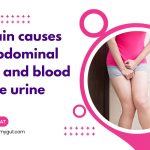Stomach Pain after Eating and Diarrhea: 7 causes, Gastroenterologist explains.
Our content is not intended nor recommended as a substitute for medical advice by your doctor. Use for informational purposes only.
Various diseases and conditions can lead to stomach pain after eating and diarrhea.
The most common causes of stomach pain and diarrhea after eating include:
- Irritable bowel syndrome (IBS).
- Food intolerance, such as lactose intolerance.
- Infections, whether acute or chronic.
- Gallbladder diseases and bile acid diarrhea.
- Pancreatic diseases (especially chronic pancreatitis).
- Celiac diseases (gluten sensitivity).
- Inflammatory bowel disease as Crohn’s disease and ulcerative colitis.
- Medication-induced diarrhea.
- Small Intestinal Bacterial Overgrowth (SIBO).
- Others, such as endocrinal diseases, Gastrointestinal cancers, etc.
This article will mainly focus on the CHRONIC causes of abdominal pain and diarrhea after eating.
The items below are in the order of commonality. Next, we will discuss the features suggesting each disease or condition.
However, The symptoms are overlapping and similar across many of them. I will do my best to explain the differences. But, the differentiation ultimately needs an evaluation by your doctor.
1. Irritable Bowel Syndrome.
Irritable bowel syndrome is a widespread disease. About 10% to 15% of the world has IBS (reference). Also, many people who have IBS don’t know they have it.
The exact cause of IBS is still unclear. However, sensitivity to food, such as FODMAPs, and psychological stress are significant factors.
Features suggesting you have IBS:
- Recurrent abdominal pain (at least one day per week for the last three months).
- The onset of pain is associated with defecation: pain is often relieved by a bowel movement.
- Changes in stool form and frequency: the stool becomes harder (constipation) or loose (diarrhea).
- The pain is triggered by stress and food.
- Bloating and distension are frequent with IBS.
- The Diarrhea-predominant IBS presents with recurrent attacks of abdominal pain and diarrhea after eating.
- Mucus in stool is considered normal with IBS.
- IBS is a functional disease. Fever, weight loss, and night diarrhea are NOT features of IBS.
Unfortunately, we don’t Have a specific test to diagnose diarrhea. Your doctor diagnoses IBS based on particular symptom criteria after excluding other similar causes.
We use symptom-based criteria to diagnose IBS called the ROME IV criteria. Learn more about how IBS is diagnosed here.
IBS treatments aim to control the symptoms and prevent a flare-up.
2. Food intolerance.
Your digestive system may be unable to handle certain types of food or constituents. Trouble digesting or absorbing certain foods can lead to stomach pain and diarrhea after eating.
Food intolerance is surprisingly common. The most prominent type of food intolerance is lactose intolerance. Studies estimate that up to 25% of the white population is lactose intolerant (reference).
Typical forms of food intolerance include:
- Lactose intolerance: in milk and dairy products.
- Fructose intolerance: a sugar present in most fruits and honey.
- FODMAPs intolerance: common with IBS.
- Caffeine intolerance.
- Histamine and histamine-like compounds (berries, fish, and sauerkraut).
- Serotonin intolerance (in bananas and tomatoes).
- Alcohol intolerance.
- Others, Learn More.
Features suggesting you have food intolerance:
- Abdominal pain soon after ingesting the offending food (such as dairy in lactose intolerance.
- Diarrhea after you consume the offending food.
- Bloating and excessive gas.
- Nausea and maybe vomiting.
- The more you eat from the offending food, the more severe the symptoms.
- Diarrhea and stomach pain go away after you stop eating the symptom-inducing food.
Consult your doctor if you notice a pattern or relation of your symptoms to certain foods.
Your doctor will perform an intolerance test to diagnose your condition. For example, Lactose intolerance is diagnosed via a breath test.
Learn more about food intolerance.
MORE: Diarrhea and Stomach Pain After Eating Ice Cream.
3. Infections (gastroenteritis, acute and chronic).
We are discussing the causes of chronic abdominal pain and diarrhea. Acute diarrhea and abdominal pain are almost exclusively caused by infection and food-borne illnesses (food poisoning).
However, infections can also lead to chronic diarrhea and abdominal pain.
Common causes of chronic gastrointestinal infections that lead to diarrhea and stomach pain:
- Closteroides are difficult infections.
- Protozoa: Chronic giardiasis, cryptosporidia, cyclosporine.
- Yersinia bacteria.
Features suggesting chronic infection:
- Chronic abdominal pain and diarrhea. Eating can cause more diarrhea; however, diarrhea may continue even if you stop eating.
- Fever may occur. It is usually low-grade in chronic infections.
- Mucus or blood in the stool.
- Weight loss and fatigue.
- Diarrhea and stomach pain after eating is usually continuous rather than intermittent.
- Nausea.
- Malaise and muscle aches.
- Fatty or greasy stool (especially with chronic giardiasis).
Your doctor will require some tests to diagnose the cause of infections. Commonly, stool analysis and stool culture.
4. Gallbladder-related diseases and bile acid diarrhea.
The gallbladder and biliary system are essential to chronic diarrhea and abdominal pain.
Various gall-bladder-related and bile-related diseases can lead to such symptoms. For example:
- Presence of gallbladder stones.
- Inflammation of the gall bladder.
- Removal of your gallbladder (post-cholecystectomy diarrhea).
- Bile acid diarrhea (BAD): due to trouble absorbing bile from your intestine.
Features suggestive of bile-related diarrhea:
- History of gallstones or removal of your gallbladder.
- Stomach pain in the upper-middle or the upper-right stomach after eating.
- The pain may spread to the right side of your abdomen and the back of the right shoulder.
- Characteristic nausea after meals with the sense of impending vomiting.
- The onset of abdominal pain and diarrhea started after removing your gallbladder (post-cholecystectomy diarrhea).
- Diarrhea with severe urgency to the extent of soiling accidents (suggestive of bile acid malabsorption.
Learn more about post-cholecystectomy diarrhea.
Learn more about bile acid diarrhea.
5. Pancreatic disease.
Chronic inflammation of the pancreas leads to the destruction of pancreatic tissue. In addition, a deficiency of pancreatic digestive enzymes leads to stomach pain and diarrhea after eating.
The condition of impaired pancreatic function is called exocrine pancreatic insufficiency or EPI (reference).
Often, chronic pancreatitis follows a previous attack of acute pancreatitis.
Features suggestive of chronic pancreatitis and EPI:
- Pain in the upper-middle part of your abdomen.
- The pain is usually more severe and constant. It doesn’t respond to traditional OTC antispasmodics and stomach medications.
- Diarrhea after eating (especially after eating fatty foods).
- Oily or greasy stool.
- Nausea and vomiting.
6. Celiac disease.
Celiac disease is an extreme form of food intolerance. It results from a severe immune-mediated reaction to gluten.
Gluten is a constituent of wheat, rye, and barley. Eating foods containing gluten leads to severe symptoms and malabsorption.
Features suggesting you have celiac disease:
- Chronic diarrhea, especially after eating gluten.
- Recurrent abdominal pain.
- Nausea and excessive gas.
- Nausea and vomiting.
- Fatty or oily diarrhea.
- Weight loss.
- Fatigue.
- Loss of appetite (anorexia).
- Signs of anemia as shortness of breath, fatigue, and fast heartbeats.
- Malabsorption and vitamin deficiency symptoms include bone pain, loss of hair, poor skin health, and others.
7. Inflammatory bowel diseases.
An inflammatory bowel disease is a severe form of digestive system inflammation. Widespread inflammation and ulcers affect the lining of your digestive system (reference).
Two main types of IBD:
- Ulcerative colitis: the inflammation is in the colon and the rectum.’h
- Crohn’s disease: the inflammation affects any part of your digestive system from the mouth to the anus.
Features suggestive of IBD:
- Chronic abdominal pain (especially after eating).
- Change in bowel habits (mainly diarrhea, but sometimes constipation).
- Blood in stool or bloody diarrhea.
- Mucus in the stool.
- Fatigue.
- Fever.
- Weight loss.
- Nausea and vomiting.
- Loss of appetite.
- Joint pain.
- Ulcers around the mouth or anus (with Crohn’s disease).
8. Medication-induced diarrhea.
Diarrhea and stomach pain after eating can be a result of drugs. More than 700 medications can induce diarrhea. Check your list of medicines for:
- Antibiotics such as penicillins, cephalosporins, and others.
- Some diabetes medications, such as metformin.
- Chronic laxative use.
- Chemotherapy.
- Immunosuppressive drugs (used for autoimmune diseases) such as rheumatoid arthritis.
The complete list is HERE and HERE.
9. Others (less common).
A. Colorectal cancer.
B. Endocrinal diseases.
C. Diabetes Mellitus.
D. Malabsorption syndrome.
E. Food allergy.
F. SIBO (small intestinal bacterial overgrowth).
- Evidence-based
- Written by a doctor.







